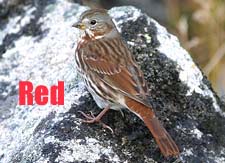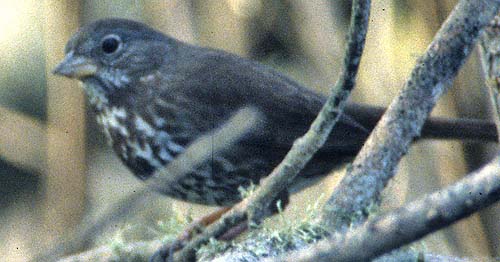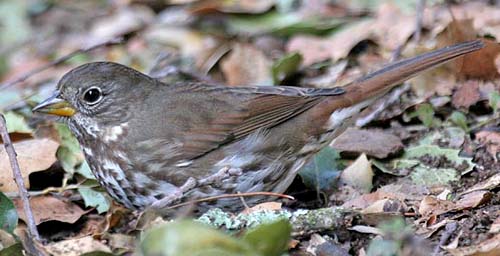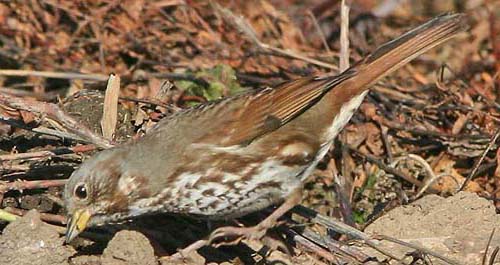
a web page by Don Roberson |
|||||||||
|
Fox Sparrow Passerella iliaca is a winter visitor and migrant to Monterey County in central California, but an understanding of its local occurrence and identification requires a fundamental knowledge of its breeding range and major variations. There are four major groups to learn — it is possible these might be split into four separate species sometime in the future — and this web project focuses on those distinctions. There is good news for the learner, though: birds in winter — indeed, birds in any plumage — look pretty much the same as adults on the breeding grounds. So if we can learn the identification of birds on the breeding grounds, it may go a long ways to learning how to identify them on the central California coast. The table below summarizes the points to be emphasized in this discussion. |
||||||||||||||||||||||||||||||
|
||||||||||||||||||||||||||||||
|
||||||||||||||||||||||||||||||
In California, Fox Sparrows breed only at high elevation in the mountains, but they breed at lower elevation as one progresses northward. Most of their breeding range is blanketed with snow in winter, which means that most of the world's population of Fox Sparrow migrates south (or in some cases, downslope) in winter. Sooty Fox Sparrows winter along the entire California coast, but Slate-colored and Thick-billed Fox Sparrows winter primarily in southern California chaparral habitats. Red Fox Sparrows winter in brushy habitat across the southern United States. What this means for coastal central California — and particularly Monterey County — is that Sooty Fox Sparrow is our common migrant and winter visitor, while the others occur mostly in migration as they head to or from southern California. Slate-colored is scarce but annual, primarily in Oct-Nov and again in March-April, but Thick-billed and Red Fox Sparrows are quite rare. We suspect that the few records of singing birds in mid-summer, though, are Thick-bills. So, from a MTY perspective, the local status is: |
||||||||||||||||||||||||||||||
|
||||||||||||||||||||||||||||||
There is growing evidence that there are four primary evolutionary lineages in Fox Sparrow, but that are also complications. A number of the groups do interbreed where ranges meet — there are apparent hybrid zones where Red meets Slate-colored, and Slate-colored meets Sooty, and Slate-colored meets Thick-billed. The northernmost race of Slate-colored [altivagans] is particularly variable. Some useful references are:
|
||||||||||||||||||||||||||||||
The identification of the four groups is still being worked out, and limits between various subspecies (and indeed groups, where they meet) are not well delineated. In the field we might be able to place most Fox Sparrows into a particular group, and even into a specific set of subspecies, but true subspecific diagnosis requires comparison with a good specimen collection. Nonetheless there is some good literature, and there have been excellent on-line discussions in groups such as Frontiers of Bird Identification. I have particularly used these texts:
Acknowledgments: I learned a lot from the literature cited above, from my own review in specimens in the past (documented with photos), and from reading discussion group comments from a wide number of North American observers. I think Kimball Garrett for responding to some follow-up questions. I very much appreciate the work of some great local photographers who permitted me to use their photos and discussed them in follow-up emails. Especially helpful were Tom Grey, Glen Tepke, and Brian Sullivan. |
||||||||||||||||||||||||||||||
|
||||||||||||||||||||||||||||||
Rant: A little knowledge is a dangerous thing. Most birders now know there are four groups of Fox Sparrows which, if they were to be split, would be called Red Fox Sparrow Passerella iliaca, Sooty Fox Sparrow Passerella unalaschcensis, Slate-colored Fox Sparrow Passerella schistacea, and Thick-billed Fox Sparrow Passerella megarhyncha. Yet these are not yet split — they are simply evolutionary 'groups' of subspecies within the currently defined species Fox Sparrow P. iliaca. But some birders/photographers like to be hot shots with their new information, and if they see a Sooty Fox Sparrow, for example, they will label it taxonomically as Passerella iliaca unalaschcensis. I've even seen list for birding tour companies give such a name to a Sooty Fox Sparrow. But Passerella iliaca unalaschcensis is the current name of only the westernmost of the 6 subspecies thought to be included within the Sooty Fox Sparrow group. If you photograph a Sooty Fox Sparrow in Vancouver, for example, the odds are very heavy that it is not Passerella iliaca unalaschcensis; it is likely to be P. i. fuliginosa which nests nearby, or a migrant of another race. Yet, if one does an Internet search, you get a ton of mislabeled photos, including some from Vancouver (which look just like fuliginosa to me). The misuse of trinomials by the public has made it virtually impossible to use the Internet to learn anything useful about Fox Sparrows. If one does wish to label a record or a photo to one of the four groups, there are several acceptable ways to do so:
|
||||||||||||||||||||||||||||||
Photos: All photos © Don Roberson, except as otherwise indicated; all rights reserved. Literature cited:
|








